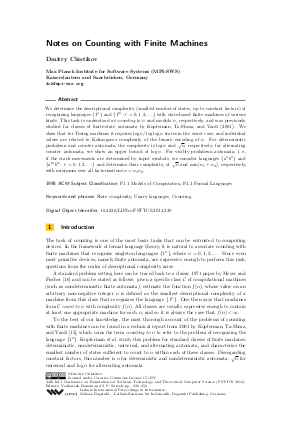Notes on Counting with Finite Machines
Author Dmitry Chistikov
-
Part of:
Volume:
34th International Conference on Foundation of Software Technology and Theoretical Computer Science (FSTTCS 2014)
Part of: Series: Leibniz International Proceedings in Informatics (LIPIcs)
Part of: Conference: IARCS Annual Conference on Foundations of Software Technology and Theoretical Computer Science (FSTTCS) - License:
 Creative Commons Attribution 3.0 Unported license
Creative Commons Attribution 3.0 Unported license
- Publication Date: 2014-12-12
File

PDF
LIPIcs.FSTTCS.2014.339.pdf
- Filesize: 470 kB
- 12 pages
Document Identifiers
Subject Classification
Keywords
- State complexity
- Unary languages
- Counting
Metrics
- Access Statistics
-
Total Accesses (updated on a weekly basis)
0PDF Downloads0Metadata Views
Abstract
We determine the descriptional complexity (smallest number of states, up to constant factors) of recognizing languages {1^n} and {1^{t n} : t = 0, 1, 2, ...} with state-based finite machines of various kinds. This task is understood as counting to n and modulo n, respectively, and was previously studied for classes of finite-state automata by Kupferman, Ta-Shma, and Vardi (2001). We show that for Turing machines it requires log(n)/log(log(n)) states in the worst case, and individual values are related to Kolmogorov complexity of the binary encoding of n. For deterministic pushdown and counter automata, the complexity is log(n) and sqrt(n), respectively; for alternating counter automata, we show an upper bound of log(n). For visibly pushdown automata, i.e., if the stack movements are determined by input symbols, we consider languages {a^n b^n} and {a^{t n} b^{t n} : n t = 0, 1, 2, ...} and determine their complexity, of sqrt(n) and min(n_1 + n_2), respectively, with minimum over all factorizations n = n_1 n_2.
Cite As Get BibTex
Dmitry Chistikov. Notes on Counting with Finite Machines. In 34th International Conference on Foundation of Software Technology and Theoretical Computer Science (FSTTCS 2014). Leibniz International Proceedings in Informatics (LIPIcs), Volume 29, pp. 339-350, Schloss Dagstuhl – Leibniz-Zentrum für Informatik (2014)
https://doi.org/10.4230/LIPIcs.FSTTCS.2014.339
BibTex
@InProceedings{chistikov:LIPIcs.FSTTCS.2014.339,
author = {Chistikov, Dmitry},
title = {{Notes on Counting with Finite Machines}},
booktitle = {34th International Conference on Foundation of Software Technology and Theoretical Computer Science (FSTTCS 2014)},
pages = {339--350},
series = {Leibniz International Proceedings in Informatics (LIPIcs)},
ISBN = {978-3-939897-77-4},
ISSN = {1868-8969},
year = {2014},
volume = {29},
editor = {Raman, Venkatesh and Suresh, S. P.},
publisher = {Schloss Dagstuhl -- Leibniz-Zentrum f{\"u}r Informatik},
address = {Dagstuhl, Germany},
URL = {https://drops.dagstuhl.de/entities/document/10.4230/LIPIcs.FSTTCS.2014.339},
URN = {urn:nbn:de:0030-drops-48547},
doi = {10.4230/LIPIcs.FSTTCS.2014.339},
annote = {Keywords: State complexity, Unary languages, Counting}
}
Author Details
References
- Rajeev Alur and P. Madhusudan. Adding nesting structure to words. J. ACM, 56(3):16:1-43, 2009. Revised version available at http://robotics.upenn.edu/~alur/Jacm09.pdf.
-
Jean-Camille Birget. Two-way automata and length-preserving homomorphisms. Mathematical Systems Theory, 29(3):191-226, 1996.

- Can one-way alternating automata with one-counter recognize some unary non-regular languages? http://cstheory.stackexchange.com/q/19046/13649, 2013-2014.
-
Gregory J. Chaitin. On the length of programs for computing finite binary sequences. J. ACM, 13(4):547-569, 1966.

-
Ashok K. Chandra, Dexter C. Kozen, and Larry J. Stockmeyer. Alternation. J. ACM, 28(1):114-133, 1981.

-
Moses Charikar, Eric Lehman, Ding Liu, Rina Panigrahy, Manoj Prabhakaran, Amit Sahai, and abhi shelat. The smallest grammar problem. IEEE Transactions on Information Theory, 51(7):2554-2576, 2005.

-
Dmitry Chistikov and Rupak Majumdar. Unary pushdown automata and straight-line programs. In ICALP'14, Part II, volume 8573 of LNCS, pages 146-157, 2014.

-
Marek Chrobak. Finite automata and unary languages. Theor. Comput. Sci., 47(3):149-158, 1986.

-
Yuval Filmus. Lower bounds for context-free grammars. Inf. Process. Lett., 111(18):895-898, 2011.

-
Matthew M. Geller, Harry B. Hunt III, Thomas G. Szymanski, and Jeffrey D. Ullman. Economy of description by parsers, DPDA’s, and PDA’s. Theor. Comput. Sci., 4(2):143-153, 1977.

-
Seymour Ginsburg and H. Gordon Rice. Two families of languages related to ALGOL. J. ACM, 9(3):350-371, 1962.

- Orna Kupferman, Amnon Ta-Shma, and Moshe Y. Vardi. Concurrency counts. Technical report, available at http://www.cs.tau.ac.il/~amnon/Papers/KTV.submitted.cjtcs.ps, 2001.
-
Ernst L. Leiss. Succinct representation of regular languages by boolean automata. Theor. Comput. Sci., 13(3):323-330, 1981.

-
Ming Li and Paul M. B. Vitányi. An introduction to Kolmogorov complexity and its applications. Texts and monographs in computer science. Springer, 1993.

-
Markus Lohrey. Algorithmics on SLP-compressed strings: a survey. Groups Complexity Cryptology, 4(2):241-299, 2012.

-
Albert R. Meyer and Michael J. Fischer. Economy of description by automata, grammars, and formal systems. In SWAT (FOCS) 1971, pages 188-191, 1971.

-
Alexander Okhotin, Xiaoxue Piao, and Kai Salomaa. Descriptional complexity of input-driven pushdown automata. In Dassow Festschrift 2012, volume 7300 of LNCS, pages 186-206, 2012.

-
Alexander Okhotin and Kai Salomaa. Complexity of input-driven pushdown automata. SIGACT News, 45(2):47-67, 2014.

-
Giovanni Pighizzini. Deterministic pushdown automata and unary languages. Int. J. Found. Comput. Sci., 20(4):629-645, 2009.

-
Giovanni Pighizzini, Jeffrey Shallit, and Ming-wei Wang. Unary context-free grammars and pushdown automata, descriptional complexity and auxiliary space lower bounds. J. Comput. Syst. Sci., 65(2):393-414, 2002.

-
Wojciech Rytter. Grammar compression, LZ-encodings, and string algorithms with implicit input. In ICALP'04, volume 3142 of LNCS, pages 15-27, 2004.

-
Kai Salomaa. Limitations of lower bound methods for deterministic nested word automata. Inf. Comput., 209(3):580-589, 2011.

